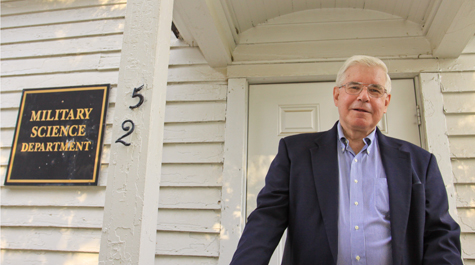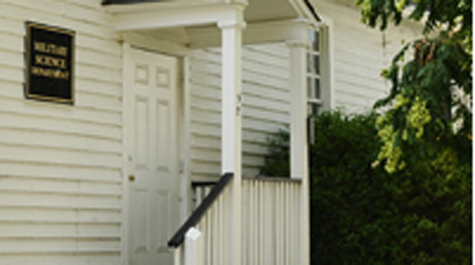English professor Meyers uncovers new details of College's past
Terry Meyers was sitting in his car, preparing to drive home for lunch and to let out the dog, when he made a decision seven years ago that has shed light on a startling and important piece of William & Mary’s 18th century history that had been completely overlooked.
Meyers, now Chancellor Professor of English at the College, has uncovered what he believes is the building occupied by the Bray School, funded by the Associates of Dr. Bray, an 18th century London philanthropy dedicated to the religious education of free and enslaved blacks in the British colonies. The Bray School existed in Williamsburg from 1760-1774.
Meyers’ research points to a structure that now sits at 524 Prince George Street, just off the edge of William & Mary’s main campus. The building has gone through many structural changes and now houses several of the College’s Military Science offices. Should he be right, Meyers will have scored an historical coup, as he explained in his recent article in the journal Anglican and Episcopal History.
“If the evidence that the structure itself housed the Bray School is convincing, the building is apparently the oldest extant building in America associated with black education,” Meyers wrote in his AEH article.
It’s just that no one knows with complete certainty. The evidence points in that direction, and the consensus among scholars is that Meyers’ work, while not conclusive, is compelling.
But as Daniel Kurt Ackermann ’04, a preservation expert, concluded in a report he produced in 2009 for the College, “Until further evidence comes to light, it is impossible to establish firmly and without a doubt the location of the Bray School in Williamsburg.”
The Bray School would have been host to as many as 30 free and enslaved black children who were taught to read and write, with the girls additionally being taught to sew. Besides their daily lessons, they would have marched down to Bruton Parish Church on Duke of Gloucester Street for religious services.
Meyers’ journal article is just the latest in a spate of major-media stories exploring his work. The Chronicle of Higher Education published a story last spring, quickly followed by a lengthy feature in The Washington Post.
The story behind Meyers’ discovery has twists and turns that include a beloved Founding Father, a bizarre case of uncertain identity, and a southern university examining its conscience in an academic manner as it grapples with its history of involvement with slavery.
Looking for Brown Hall
It began when Meyers, a 40-year teaching veteran with a penchant for 19th century Williamsburg history, tried to locate a Brown Hall. It was not the Brown Hall that stands today on Prince George Street, but an earlier structure on the same site described in a book entitled Williamsburg Facts & Fiction: 1900-1950 as having been owned by a Dudley Digges and moved from its original location at Prince George and Boundary.
That was news to Meyers, who knew of a Dudley Digges who had been a Revolutionary War patriot and had resided in a now-famous restored home in Yorktown. Meyers asked two sources he valued about this other Digges House supposedly on campus. It was news to them, too.
Meyers kept exploring, and found two other written references to a Digges House in Williamsburg. The memoir of a man who grew up in 19th century Williamsburg actually described the cottage. And a Flat Hat story from 1930 found in Swem Library’s Special Collections Research Center mentioned the house as having been moved to Prince George Street.
But no house along Prince George Street seemed to resemble an 18th century cottage. Had it been torn down? Was there anything at all still to find?
Those were the questions nagging Meyers as he turned the ignition key and headed for home.
“I had decided to quit,” he admitted recently. “I said to myself, ‘If that move happened, the building must have been torn down.’ “
But the fact that he had three independent written references to the house ate at Meyers. He couldn’t let go.
Meyers combed through Colonial Williamsburg’s Special Collections at the Rockefeller Library, Colonial Williamsburg’s York County Project in the Department of Historical Research, and the archives in the Goodwin Building. He pored over files and microfilm of newspapers from William & Mary and Williamsburg, Newport News, and Richmond. He screened college records, building files, and presidential papers at Swem Library, along with annual reports of the Methodist Woman’s Missionary Society. William & Mary yearbooks and aerial photos only added fuel to his fire.
“I had help and advice from everyone, from reference librarians and archivists at the College and Colonial Williamsburg and historians at Colonial Williamsburg to Louise Kale (executive director of the Historic Campus),” Meyers said. “Even when I started working on the AEH article, I didn’t know enough. But I kept running into people who knew more than I knew, though none knew the whole story.”
Ultimately, he found that there were several men named Dudley Digges “running around” the Tidewater area in the mid-18th century. Two of them even seemed to have held the rank of Colonel, the patriot from Yorktown and, as Daniel Ackermann subsequently documented, a lesser-known Digges in Williamsburg.
It’s the latter Digges, Meyers asserts, who rented and then owned the home that served as the school, which he apparently subleased and then rented to the school mistress.
“There’s a lot of complexity,” Meyers said.
The Franklin connection
How there even came to be a Bray School in Williamsburg is a puzzle Meyers’ dogged sleuthing appears to have solved, and is chronicled in his AEH article.
In 1756, Benjamin Franklin came to Williamsburg on post office business. The faculty took the opportunity to award him the first honorary degree bestowed by the College. Franklin met the president of the school, Thomas Dawson, during his visit. Dawson’s interest in the religious education of blacks was well known, and would have resonated with Franklin, Meyers said.
But Dawson’s commitment to black religious education was shared.
Bishop Henry Compton, the College’s first chancellor, espoused Dr. Bray’s philosophy by challenging Virginia’s royal governors to “find out the best means to facilitate and encourage the conversion of Negroes and Indians to the Christian religion.”
In 1699, the College’s first president, James Blair, urged the Virginia General Assembly to encourage “the Christian education of Indians, negroes, and mulatto children.” The Assembly had earlier endorsed the Brafferton School’s educating American Indians, but refused Blair’s plea on behalf of blacks.
In 1740, professor William Dawson, later president of the College, was communicating with the bishop of London, attempting to secure “a collection of religious books to be approved of, by your Lordship, for the benefit of the Negroes and the Poor of this Colony.”
As a clergyman, William Dawson had overseen three schools for blacks in his parish. As president of the College, he looked forward to the establishment of another one in Williamsburg, Meyers said. He himself presided over Lenten instruction to students from the College, Indians, white indentured servants, and blacks – all in one classroom. And, the professor added, Dawson helped raise funds for a school in Maryland for religious education, including blacks, using the Great Hall for concerts and contributing himself about $1,000 in today’s money.
Meyers reports that in 1758, on Franklin’s advice, the Associates of Dr. Bray had funded a school for blacks in Philadelphia. It was very successful and in 1760, the Associates elected Franklin a member. This time, they told him that they wanted to open three schools for the education of blacks, and asked him to suggest locations.
Franklin offered New York and Newport, R.I., and then what must have been a shocker: Williamsburg, a southern city firmly embedded in the culture of slavery.
“I didn’t discover any new documents or manuscripts,” Meyers said. “Everything I worked with was already out there in print. But no one had ever put it all together to make a connection between Franklin’s visit in 1756 and his recommendation to the Associates four years later that Williamsburg be a site for a school.
“That’s when I began to realize that the college, astonishingly, had a track record in the 1740s and 1750s, through its presidents and faculty, of really being engaged in the religious education of slaves and free blacks. That’s what Franklin discovered and what drove the recommendation of Williamsburg and the Associates’ looking for an affiliation with the College.”
That’s a far different scenario than previously believed. It had always been accepted as fact that Williamsburg came to have a Bray School solely because of Franklin’s close friendship with a resident named William Hunter. Like Franklin, Hunter was a postmaster and a printer.
There should be no misunderstanding the motivation for educating slaves and free blacks, Meyers said. The men behind the movement were clergy who believed enslaved blacks needed to be baptized. In order to understand the tenets of Christianity, they had to be able to read and write. Almost none of the clergy were opposed to slavery, he said.
“Although William & Mary was the first institution to concern itself with the education of blacks in America,” Meyers said, “there has to be a series of asterisks and footnotes to that claim.”
Meyers said his inquiries had intensified when he learned that the College owned two slave children, Fanny and Adam. Both attended the Bray School, Meyers said, but only after it was moved from its original location, where Brown Hall is today.
The Lemon Project
Meyers’ research is as timely as it is fascinating. A committee of faculty, staff, students, and community members is currently studying and exploring the role of race in the College's history as part of the Lemon Project, named for a slave the College owned in the early 19th century.
The initiative, launched following a resolution in April 2009 by the William & Mary Board of Visitors, is a multiyear effort to better understand William & Mary's own connections to slavery as well as race relations at the College from the end of the Civil War to date.
“I think William & Mary is going through a full examination of its conscience,” Meyers said. “We’re documenting what we’ve done – good, bad, or indifferent – and it’s nuanced. There’s good, and there’s bad, in our history of race relations. I think we are therefore out ahead of most southern universities. I think this process of historical investigation is the honest way to go. I think William & Mary is doing it the honorable way.”
Meyers nods his head and laughs when someone suggests that the story of a professor of Victorian poetry discovering something that eluded untold scores of research historians defines the value of a liberal-arts education.
“It sometimes startles me how serendipitous and chancy the connections are,” he said, “but everything seemed to come together.
“The Washington Post story said something about Williamsburg being a place where the bones of history had been picked clean. A friend of mine saw that and said, ‘Terry, you’ve just proven that there’s still a bit more meat on those bones.’ ”

















